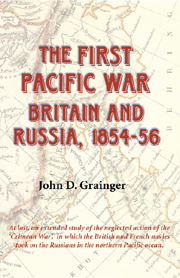Book contents
6 - The Sea of Okhotsk
Published online by Cambridge University Press: 12 September 2012
Summary
Elliot took his new squadron out of Hakodate on 10 July. He examined the former Russian post at Muravevsk, which the British called Aniwa, and which they at last realised was Russian – this was what had worried the Japanese – and saw that it was deserted. The Japanese village had been reoccupied even while the Russians were present. The squadron then sailed north along the east coast of Sakhalin. Elliot took a week on the voyage, examining the coasts and bays in search of any more Russian settlements. None were found.
At the north cape of Sakhalin, Cape Elizabeth, Elliot met Barracouta and discovered that the Sea of Okhotsk had been under British investigation, even a distant sort of control, for the previous month. The captain of Barracouta was Commander F. H. Stirling, Admiral Stirling's son. He explained the situation to Elliot: the three ships had arrived at Cape Elizabeth on 24 June. This was long after the Russian ships had vanished from the north of the Gulf of Tartary, and while Elliot in Hornet was about to be sent to look into De Castries Bay again. Elliot included a paragraph in his report in which he argued that the timing of the arrival of the three ships from Petropavlovsk was such that the Russians could well have escaped southwards, through La Pérouse Strait and into the Amur from the north before these British ships arrived.
- Type
- Chapter
- Information
- The First Pacific WarBritain and Russia, 1854–56, pp. 114 - 137Publisher: Boydell & BrewerPrint publication year: 2008



